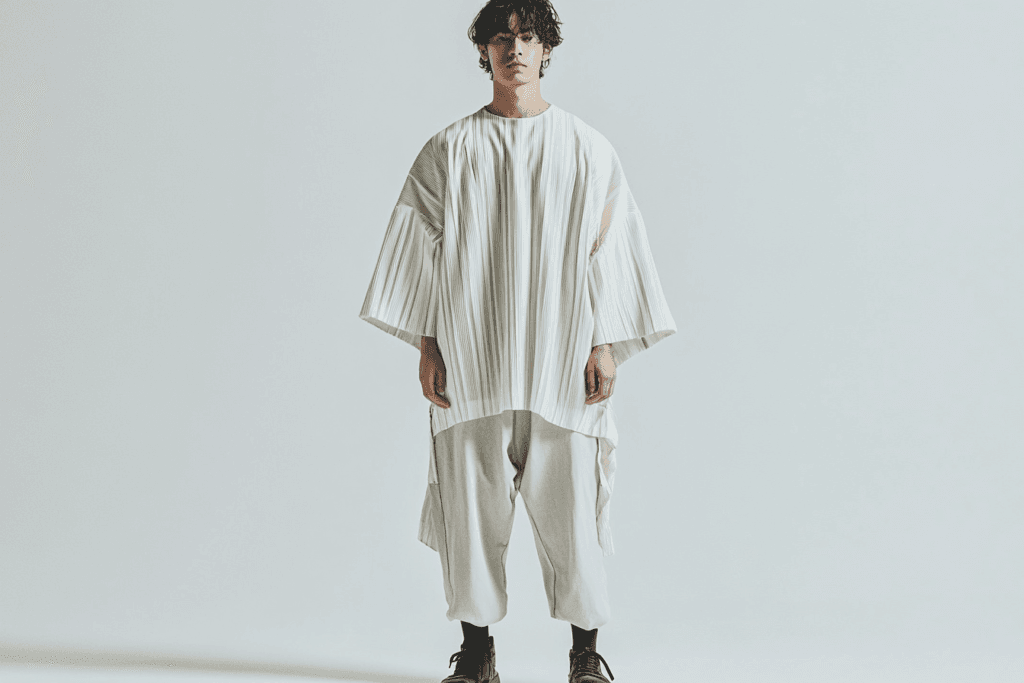
Choosing the right bamboo shirt fabric can make a big difference in your wardrobe. High-quality fabric ensures comfort, lasts longer, and supports sustainable living.
Bamboo, as a resource, offers incredible environmental benefits. It regenerates in just 3 to 5 years and requires minimal water to grow. Additionally, bamboo forests release 30% more oxygen into the air than trees and can absorb up to 12 tons of carbon dioxide per hectare.
With so many advantages, how can you identify the best bamboo fiber shirt fabric for your needs?
Key Takeaways
- Pick bamboo fabric shirts for comfort and strength. Good bamboo fabric feels soft, airy, and lasts long.
- Search for labels like OEKO-TEX and GOTS. These prove the fabric is safe for the planet and people.
- Look at thread count and weave style. More threads make softer fabric, and weaves change how it feels and looks.
- Choose 100% bamboo fabric for better eco-friendliness. Mixed fabrics might be cheaper but are less green.
- Check reviews before buying. Reviews tell you if the fabric is good and help you avoid bad ones.
How Can You Better Understand Bamboo Shirt Fabric?

What is Bamboo Fiber
Bamboo fiber is a natural material derived from the pulp of bamboo plants. It is known for its eco-friendly properties and versatility in textiles. The fiber undergoes processing to create a soft, breathable fabric that feels luxurious against the skin. Bamboo fiber stands out for its unique combination of strength and softness. For instance, its dry tensile strength measures 2.33 cN/dtex, while its wet tensile strength is 1.37 cN/dtex. These properties make it durable yet comfortable for everyday wear. Additionally, bamboo fiber has excellent moisture absorption, with a moisture region of 13.03%, ensuring you stay dry and comfortable.
Types of Bamboo Fiber (Viscose, Lyocell, and Blends)
Bamboo fiber comes in three main types: viscose, lyocell, and blends. Viscose bamboo fiber is created through a chemical process that transforms bamboo pulp into a silky, smooth fabric. Lyocell bamboo fiber, on the other hand, uses a more sustainable closed-loop process, making it an eco-friendlier option. Blends combine bamboo with other materials like cotton or polyester to enhance durability or reduce costs. When choosing bamboo shirt fabric, lyocell is often the best choice for sustainability, while blends may offer a balance between affordability and performance.
Benefits of Bamboo Shirt Fabric
Bamboo shirt fabric offers numerous benefits that make it a popular choice for clothing. Its softness surpasses that of cotton, providing a smooth, satin-like feel. The fabric’s moisture-wicking properties help evaporate sweat quickly, keeping you cool and dry in hot weather. Bamboo also contains a natural antimicrobial agent called “bamboo Kun,” which prevents bacteria growth and reduces odors. Additionally, bamboo shirt fabric is breathable, thermoregulating, and provides UV protection, making it suitable for various climates. Its sustainability is another key advantage, as bamboo grows rapidly without pesticides or excessive water, leaving a minimal environmental footprint.
Tip: Look for bamboo shirt fabric with certifications like OEKO-TEX or GOTS to ensure you’re purchasing eco-friendly and high-quality material.
What Key Factors Should You Consider When Choosing Bamboo Shirt Fabric?

Thread Count and Weave Type
When evaluating bamboo shirt fabric, thread count plays a crucial role in determining its quality. A higher thread count often means softer and more luxurious fabric. Most bamboo fabrics have a thread count between 150 and 400, with premium options reaching up to 500. For everyday wear, a thread count of 300 to 400 strikes the perfect balance between softness and durability.
The weave type also impacts the fabric’s texture and appearance. Bamboo sateen, for example, offers a silky finish and a smooth feel, making it ideal for formal shirts. Bamboo twill, on the other hand, provides a more structured and durable option, suitable for casual wear. Choosing the right combination of thread count and weave type ensures you get the comfort and style you need.
Material Composition (100% Bamboo vs. Blends)
The composition of bamboo shirt fabric significantly affects its performance and sustainability. Pure bamboo fabrics, such as 100% bamboo viscose or lyocell, provide unmatched softness and moisture-wicking properties. They are also highly durable and eco-friendly. However, blends like bamboo-cotton or bamboo-linen combine the benefits of bamboo with other materials, enhancing durability or reducing costs.
| Fabric Type | Market Value (2023) | Projected Value (2032) |
|---|---|---|
| 100% Bamboo Fabric | 0.93 USD Billion | 2.5 USD Billion |
| Bamboo Cotton Blends | 1.04 USD Billion | N/A |
| Bamboo Linen Blends | 0.37 USD Billion | 1.0 USD Billion |
If you prioritize sustainability and softness, opt for 100% bamboo fabrics. For a balance of affordability and durability, blends may be a better choice.
Durability, Softness, and Color Fastness
High-quality bamboo shirt fabric excels in durability, softness, and color retention. Bamboo fibers are naturally strong, with a dry tensile strength of 2.33 cN/dtex and a wet tensile strength of 1.37 cN/dtex. This ensures your shirts withstand regular wear and washing.

Softness is another hallmark of bamboo fabric, often compared to silk or cashmere. Its natural moisture-wicking and antibacterial properties keep you comfortable and odor-free throughout the day. Additionally, bamboo fabric maintains its vibrant colors over time, making it a reliable choice for long-lasting wardrobe staples.
Tip: Always check the fabric label for details about thread count, composition, and certifications to ensure you’re getting the best quality.
What Certifications Should You Look for in Bamboo Shirt Fabric?

Recognized Certifications (OEKO-TEX, GOTS, FSC)
When choosing bamboo shirt fabric, certifications play a vital role in ensuring quality and sustainability. Recognized certifications provide assurance that the fabric meets specific environmental and safety standards. Here are some key certifications to look for:
| Certification Standard | Description |
|---|---|
| OEKO-TEX® Standard 100 | Certifies that textiles are free from harmful substances. |
| Global Organic Textile Standard (GOTS) | Ensures organic fibers and responsible manufacturing processes. |
| Forest Stewardship Council (FSC) | Guarantees that bamboo comes from responsibly managed forests. |
| STeP by OEKO-TEX® | Focuses on reducing carbon footprint and water usage in textile production. |
| Ecolabel | Promotes low environmental impact throughout the product lifecycle. |
These certifications validate the fabric’s safety, sustainability, and ethical production practices. For example, OEKO-TEX® ensures that the fabric is free from harmful chemicals, while FSC confirms that the bamboo is sourced responsibly.
How to Verify Certification Authenticity
Verifying the authenticity of certifications is crucial to avoid misleading claims. Start by checking the product label or packaging for certification logos. Then, visit the certifying organization’s official website to cross-check the product or brand. Many certification bodies, such as OEKO-TEX® and GOTS, provide online databases where you can search for certified products or manufacturers.
You can also look for additional certifications like Soil Association, SKAL, or Ecocert, which focus on organic and sustainable standards. These organizations often provide detailed information about the certification process, helping you make informed decisions.
Tip: Avoid products with vague claims like “eco-friendly” or “natural” without proper certification. Always verify the source to ensure authenticity.
Importance of Eco-Friendly Certifications
Eco-friendly certifications are more than just labels; they represent a commitment to sustainability and ethical practices. For bamboo shirt fabric, certifications like FSC and GOTS ensure that the material is sourced and processed responsibly. This reduces environmental impact and promotes fair labor practices.
For instance, FSC certification guarantees that bamboo is harvested from forests managed sustainably, benefiting both the environment and local communities. Similarly, GOTS certification ensures that the fabric is made from organic fibers and adheres to strict environmental and social criteria. By choosing certified products, you support sustainable practices and contribute to a healthier planet.
Callout: Certified bamboo shirt fabric not only benefits the environment but also ensures better quality and safety for you as a consumer.
How Do Production Methods Impact the Quality of Bamboo Shirt Fabric?

Mechanical vs. Chemical Processes
The way bamboo fibers are processed significantly impacts the quality and sustainability of the fabric. Two primary methods exist: mechanical and chemical.
- Mechanical Process: This method uses natural enzymes to break down bamboo fibers. It is eco-friendly and produces high-quality fabric, often referred to as bamboo linen. However, it is labor-intensive and more expensive due to the time and effort involved.
- Chemical Process: This method, commonly used for viscose rayon, involves strong chemicals to dissolve bamboo pulp. While it is cost-effective and efficient, it poses risks to both the environment and workers’ health.
Each method has its pros and cons, but the mechanical process stands out for its minimal environmental impact and superior fabric quality.
How Production Affects Fabric Durability and Sustainability
The production method directly influences the durability and sustainability of bamboo shirt fabric. Mechanical processing creates stronger fibers, resulting in more durable fabric. This reduces the need for frequent replacements, which helps conserve resources. On the other hand, chemical processing, while efficient, can weaken the fibers over time, leading to reduced durability.
Sustainability also varies. Mechanical methods avoid harmful chemicals, making them safer for the environment. In contrast, traditional chemical processes often release pollutants, though newer techniques aim to minimize this impact. Choosing fabrics made through sustainable methods ensures better quality and a smaller ecological footprint.
Choosing Sustainable Production Methods
When selecting bamboo shirt fabric, prioritize options made using sustainable production methods. Look for labels that specify mechanical processing or eco-friendly chemical techniques. Certifications like GOTS or FSC can also indicate responsible manufacturing practices.
Tip: Opt for fabrics produced through mechanical processes whenever possible. They offer better durability, smoother texture, and a more sustainable choice for the planet.
By understanding the differences in production methods, you can make informed decisions that align with your values and ensure you get the best quality fabric.
What Are Some Practical Tips for Choosing Bamboo Shirt Fabric?

Check Labels for Material and Certifications
When selecting bamboo shirt fabric, always examine the labels carefully. These labels reveal essential details about the material composition and certifications. Opt for fabrics like bamboo linen or bamboo lyocell, which are more sustainable than chemically processed options like bamboo viscose or rayon. Labels also indicate the origin of the bamboo and whether the manufacturing process used eco-friendly methods.
Pay attention to certifications such as OEKO-TEX, GOTS, or FSC. These certifications ensure that the fabric meets environmental and safety standards. Products labeled as “rayon from bamboo” often involve chemical-intensive processes that harm the environment and pose health risks to workers. The Federal Trade Commission (FTC) has highlighted that such products lack scientific backing for claims of biodegradability. Scrutinizing labels helps you avoid misleading claims and choose truly sustainable options.
Tip: Avoid fabrics with vague terms like “natural bamboo” unless they include recognized certifications.
Feel the Fabric for Softness and Strength
Touching the fabric is one of the simplest ways to assess its quality. High-quality bamboo shirt fabric feels incredibly soft, often compared to silk or cashmere. Run your fingers over the material to check for smoothness and consistency. A premium fabric will feel luxurious without being overly slippery.
Strength is another critical factor. Gently stretch the fabric to test its durability. A good-quality bamboo fabric will resist tearing or fraying, even under slight tension. This ensures that your shirt will withstand regular wear and washing without losing its shape or texture.
Note: If you’re shopping online, look for customer reviews that mention the fabric’s softness and durability.
Buy from Trusted Brands and Retailers
Purchasing from reputable brands and retailers increases your chances of getting high-quality bamboo shirt fabric. Trusted companies often prioritize sustainable production methods, such as closed-loop systems, which reduce environmental impact. They also provide detailed product descriptions, including certifications and material composition, to help you make informed decisions.
The growing demand for eco-friendly textiles has led many manufacturers to focus on bamboo fabrics due to their softness and hypoallergenic properties. Customer reviews often highlight the comfort and breathability of these fabrics, especially for activewear. For example, one satisfied customer shared, “Love these tights! I wear them almost every time I go work out. The fabric doesn’t run or fray even if you catch it and gets a hole. They’re so soft and keep you cooler than other fabrics.”
Tip: Stick to brands with a proven track record of sustainability and transparency to ensure you’re investing in reliable products.
Read Customer Reviews and Recommendations
Customer reviews and recommendations are valuable tools when choosing bamboo fiber shirt fabric. They provide real-world insights into the quality, comfort, and durability of the fabric. By reading reviews, you can learn from the experiences of others and make a more informed decision.
Start by checking reviews on trusted e-commerce platforms or the brand’s official website. Look for comments that mention the fabric’s softness, breathability, and overall feel. Positive reviews often highlight features like long-lasting color, resistance to wear, and comfort during different weather conditions. For example, a reviewer might say, “This bamboo shirt stayed soft even after multiple washes and kept me cool during summer.”
Pay attention to negative reviews as well. These can reveal potential issues, such as shrinkage, fading, or discomfort. If multiple customers mention the same problem, it’s a red flag. However, consider whether the issue is specific to the product or due to improper care by the user.
You can also explore independent review sites or forums where people discuss sustainable clothing. These platforms often feature detailed comparisons between different brands and materials. Recommendations from friends or family members who have tried bamboo shirts can also be helpful.
Tip: Focus on reviews that provide specific details about the fabric rather than vague comments like “good quality.” Detailed feedback is more reliable and helps you understand what to expect.
By taking the time to read reviews and seek recommendations, you can avoid low-quality products and find bamboo shirt fabric that meets your expectations. This step ensures you invest in a fabric that delivers comfort, durability, and sustainability.
Choosing high-quality bamboo fiber shirt fabric offers numerous benefits for you and the environment. By understanding bamboo fiber, identifying quality indicators, and checking certifications, you can make informed decisions. Sustainable production methods further enhance the value of your choice.
| Key Point | Supporting Fact |
|---|---|
| Rapid Growth | Bamboo regenerates in 3 to 5 years, making it a renewable resource. |
| Low Water Usage | Bamboo grows with minimal rainfall, unlike water-intensive crops like cotton. |
| No Need for Pesticides | Bamboo naturally resists pests, reducing chemical use. |
| Comfort and Durability | Bamboo fabric is soft, thermoregulating, and long-lasting. |
Conclusion
Investing in high-quality bamboo fabric ensures comfort, durability, and a smaller environmental footprint. By prioritizing sustainable options, you contribute to a healthier planet while enjoying superior clothing.
FAQ
What makes bamboo fabric better than cotton?
Bamboo fabric offers superior softness, moisture-wicking, and breathability compared to cotton. It also grows faster and requires less water, making it more sustainable. Cotton, while durable, often needs pesticides and more resources to cultivate.
Tip: Choose bamboo lyocell for the best combination of comfort and eco-friendliness.
How do I care for bamboo shirts?
Wash bamboo shirts in cold water on a gentle cycle. Use mild detergent and avoid bleach. Air-dry or tumble dry on low heat to maintain softness and durability. Proper care ensures your bamboo shirts last longer.
Note: Avoid fabric softeners as bamboo fabric is naturally soft.
Are bamboo blends as eco-friendly as 100% bamboo?
Bamboo blends, like bamboo-cotton, are less eco-friendly than 100% bamboo fabrics. Blends often include materials that require more resources to produce. However, they can offer added durability and affordability.
Callout: Look for blends with a higher percentage of bamboo for better sustainability.
Does bamboo fabric shrink after washing?
Bamboo fabric may shrink slightly after the first wash, especially if exposed to high heat. Washing in cold water and air-drying minimizes shrinkage. Always check the care label for specific instructions.
Is bamboo fabric suitable for sensitive skin?
Yes, bamboo fabric is hypoallergenic and gentle on sensitive skin. Its natural antimicrobial properties reduce irritation and prevent odors. This makes it an excellent choice for people with allergies or skin conditions.
Emoji Tip: 🌱 Bamboo fabric = comfort + care for your skin!
Related:
1.How to find and care for this soft and exquisite fabric made from one of the world’s most sustainable resources →
2.What is Bamboo Fabric: Properties and Fabric Details of Bamboo Fabric →
3.Bamboo Fiber || Properties || Processing || Applications →
4.How to Spot Poor Quality vs. High-Quality Bamboo Viscose →
5.What Is Bamboo Fabric: A Beginner’s Guide For Fashion Brands →
